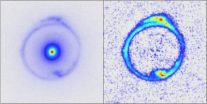(Press-News.org) Athens, Ga. – New research is revealing surprising connections between animal microbiomes—the communities of microbes that live inside animals' bodies—and animal behavior, according to a paper by University of Georgia ecologist Vanessa O. Ezenwa and her colleagues. The article, just published in the Perspectives section of the journal Science, reviews recent developments in this emerging research area and offers questions for future investigation.
The paper grew out of a National Science Foundation-sponsored workshop on new ways to approach the study of animal behavior. Ezenwa, an associate professor in the UGA Odum School of Ecology and College of Veterinary Medicine department of infectious diseases, and her coauthors were interested in the relationship between animal behavior and beneficial microbes.
Most research on the interactions between microbes and their animal hosts has focused on pathogens, Ezenwa said. Less is known about beneficial microbes or animal microbiomes, but several recent studies have begun to explore these connections.
"We know that animal behavior plays a critical role in establishing microbiomes," she said. "Once they're established, the microbiomes then influence animal behavior in lots of ways that have far-reaching consequences. That's what we were trying to highlight in this article."
Bumble bees, for example, obtain the microbes they need through social contact with nest mates, including consuming their nest mates' feces—a not uncommon method for animals to acquire microbes. Green iguanas establish their intestinal microbiomes by feeding first on soil and later on the feces of adult iguanas.
"There are a lot of behaviors that animals might have that allow them to get the different microbes they need at different points of their lives," Ezenwa said.
Microbes, in their turn, influence a wide range of animal behaviors, including feeding, mating and predator-prey interactions.
One recent study found that fruit flies prefer to mate with others that have microbiomes most similar to their own. Another found that African malaria mosquitoes were less attracted to humans who had a greater diversity of microbes on their skin, possibly because certain microbes produce chemicals that repel these mosquitoes.
Other studies have focused on understanding the mechanisms by which microbes influence behavior.
"Recent experiments have been able to assess the molecules that are involved in communication between microbes in the gut and the brain of mice, showing that microbes are associated with shifts in things like depression and anxiety in these mice," she said. "There are huge implications in the role these microbes play in regulating neural function."
Ezenwa's own work involves investigating how social behavior and interactions between organisms might increase their likelihood of acquiring parasites and pathogens. She is starting a new project examining animal behavior and microbiomes in relation to infectious disease.
"As in the example of the bumble bees, behavior might control the microbes an animal acquires, and those microbes might then influence the animal's vulnerability to pathogens," she said.
The authors conclude that it will take a combination of molecular and experimental approaches to answer questions about the complex interactions between microbiomes and animal behaviors.
"This is a new, emerging topic that's worthy of much more investigation," Ezenwa said.
###
The full article is available at http://www.sciencemag.org/content/338/6104/198.full?sid=45ad6fa3-c906-4289-9bdb-4da1815ab59a.
The article's coauthors are Nicole M. Gerardo of Emory University; David W. Inouye of the Rocky Mountain Biological Laboratory and the University of Maryland; Monica Medina of the University of California, Merced; and Joao B. Xavier of the Memorial Sloan-Kettering Cancer Center.
New studies reveal connections between animals' microbial communities and behavior
2012-10-12
ELSE PRESS RELEASES FROM THIS DATE:
Enzyme triggers cell death in heart attack
2012-10-12
University of Iowa researchers have previously shown that an enzyme called CaM kinase II plays a pivotal role in the death of heart cells following a heart attack or other conditions that damage or stress heart muscle. Loss of beating heart cells is generally permanent and leads to heart failure, a serious, debilitating condition that affects 5.8 million people in the United States.
Now the UI team, led by Mark Anderson, M.D., Ph.D., professor and head of internal medicine at the UI Carver College of Medicine, has honed in on how CaM kinase II triggers heart cell death ...
New treatments for epilepsy, behavioral disorders could result from Wayne State studies
2012-10-12
Three studies conducted as part of Wayne State University's Systems Biology of Epilepsy Project (SBEP) could result in new types of treatment for the disease and, as a bonus, for behavioral disorders as well.
The SBEP started out with funds from the President's Research Enhancement Fund and spanned neurology, neuroscience, genetics and computational biology. It since has been supported by multiple National Institutes of Health-funded grants aimed at identifying the underlying causes of epilepsy, and it is uniquely integrated within the Comprehensive Epilepsy Program at ...
Safety results of intra-arterial stem cell clinical trial for stroke presented
2012-10-12
HOUSTON – (Oct. 11, 2012) – Early results of a Phase II intra-arterial stem cell trial for ischemic stroke showed no adverse events associated with the first 10 patients, allowing investigators to expand the study to a targeted total of 100 patients.
The results were presented today by Sean Savitz, M.D., professor of neurology and director of the Stroke Program at The University of Texas Health Science Center at Houston (UTHealth), at the 8th World Stroke Congress in Brasilia, Brazil.
The trial is the only randomized, double-blind, placebo-controlled intra-arterial clinical ...
Satellite sees 16th Atlantic tropical depression born near Bahamas
2012-10-12
The 16th tropical depression of the Atlantic Ocean season has formed northeast of the Bahamas and NOAA's GOES-14 satellite captured a visible image of the storm as it tracks to the southwest.
NOAA's GOES-14 satellite captured a visible image of newborn Tropical Depression 16 (TD16) near the Bahamas on Oct. 11 at 7:45 a.m. EDT. TD16 appeared as a rounded area of clouds just northeast of the Bahamas and its western fringes were just off the Florida east coast. GOES-14 also showed another low pressure area with the potential for development a few hundred miles from the Windward ...
NASA sees Typhoon Prapiroon doing a 'Sit and Spin' in the Philippine Sea
2012-10-12
As Typhoon Prapiroon slowed down and became quasi-stationary in the Philippine Sea NASA's Terra satellite passed overhead and captured an image of the storm.
NASA's Terra satellite passed over Typhoon Prapiroon on Oct. 11 at 0210 UTC (1010 p.m. EDT, Oct. 10) and the Moderate Resolution Imaging Spectroradiometer (MODIS) instrument captured a visible image of the storm. The visible imagery clearly showed a small ragged eye, and microwave satellite imagery confirmed the eye. Satellite imagery also confirmed a well-defined low-level center of circulation.
By 11 a.m. EDT ...
Nurture trumps nature in study of oral bacteria in human twins, says CU study
2012-10-12
A new long-term study of human twins by University of Colorado Boulder researchers indicates the makeup of the population of bacteria bathing in their saliva is driven more by environmental factors than heritability.
The study compares saliva samples from identical and fraternal twins to see how much "bacterial communities" in saliva vary from mouth to mouth at different points in time, said study leader and CU-Boulder Professor Kenneth Krauter. The twin studies show that the environment, rather than a person's genetic background, is more important in determining the ...
When galaxies eat galaxies
2012-10-12
SALT LAKE CITY, Oct. 11, 2012 – Using gravitational "lenses" in space, University of Utah astronomers discovered that the centers of the biggest galaxies are growing denser – evidence of repeated collisions and mergers by massive galaxies with 100 billion stars.
"We found that during the last 6 billion years, the matter that makes up massive elliptical galaxies is getting more concentrated toward the centers of those galaxies. This is evidence that big galaxies are crashing into other big galaxies to make even bigger galaxies," says astronomer Adam Bolton, principal ...
Exposure to traffic air pollution in infancy impairs lung function in children
2012-10-12
Exposure to ambient air pollution from traffic during infancy is associated with lung function deficits in children up to eight years of age, particularly among children sensitized to common allergens, according to a new study.
"Earlier studies have shown that children are highly susceptible to the adverse effects of air pollution and suggest that exposure early in life may be particularly harmful," said researcher Göran Pershagen, MD, PhD, professor at the Karolinska Institutet Institute of Environmental Medicine in Stockholm, Sweden. "In our prospective birth cohort ...
Quiz, already used in elderly, could determine death risk for kidney dialysis patients of all ages
2012-10-12
A simple six-question quiz, typically used to assess disabilities in the elderly, could help doctors determine which kidney dialysis patients of any age are at the greatest risk of death, new Johns Hopkins research suggests.
Believing that kidney failure mimics an accelerated body-wide aging process transplant surgeon Dorry L. Segev, M.D., Ph.D., and his colleagues turned to geriatric experts to examine mortality risk in patients undergoing dialysis. They found that those who needed assistance with one or more basic activities of daily living – feeding, dressing, walking, ...
Integrative Psychiatrist Richard P. Brown Teaches Drug Free Approaches for ADD/ADHD to Therapists at New York Open Center, Manhattan
2012-10-12
Richard P. Brown, MD, a psychopharmacologist who integrates CAM (Complimentary and Alternative Medicine) into his treatments, will present an evening workshop on Friday, October 12, 2012, from 7 to 10 pm, at The New York Open Center, 22 E. 30th Street, New York, NY, 10016, entitled "Drug Free Approaches to Treating ADD/ADHD," for psychotherapists looking to complement their practices with herbs, nutrients, and mind-body techniques.
Dr. Richard P. Brown will share up-to-date information about a range of treatments for children and adults with Attention Deficit ...


